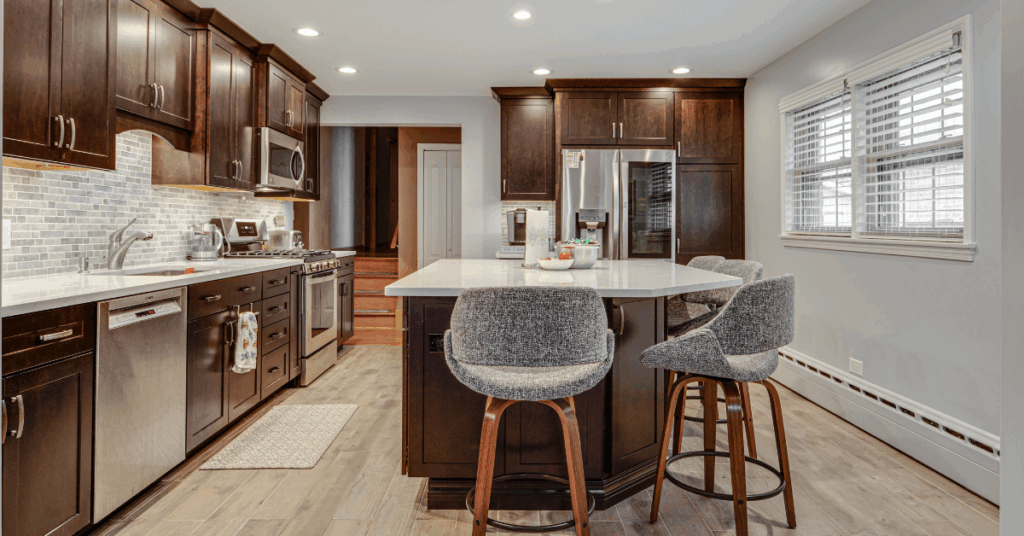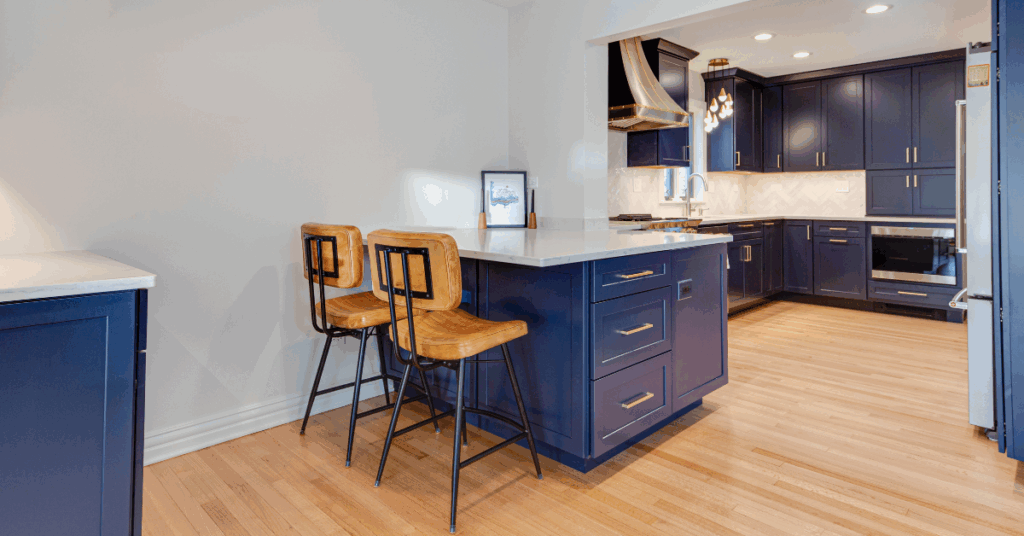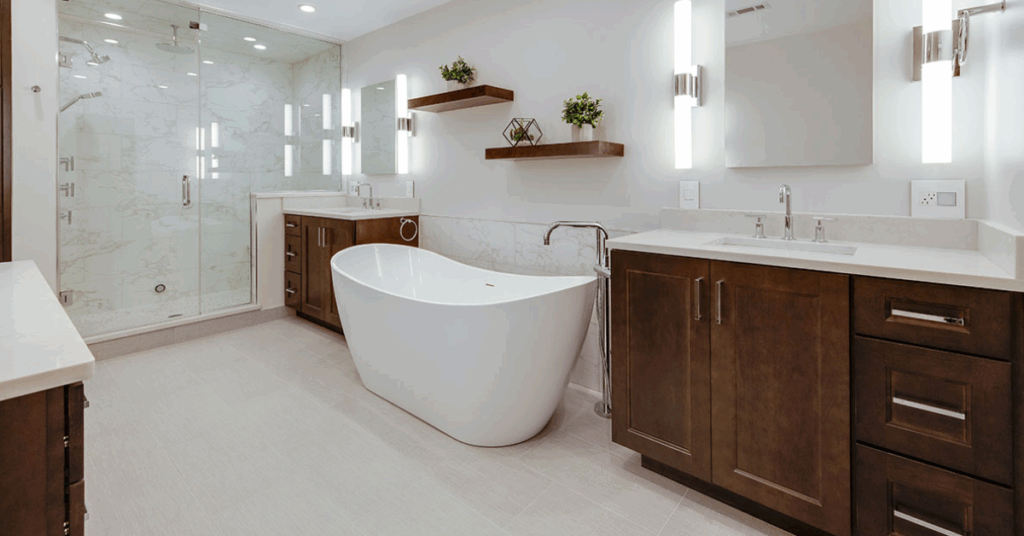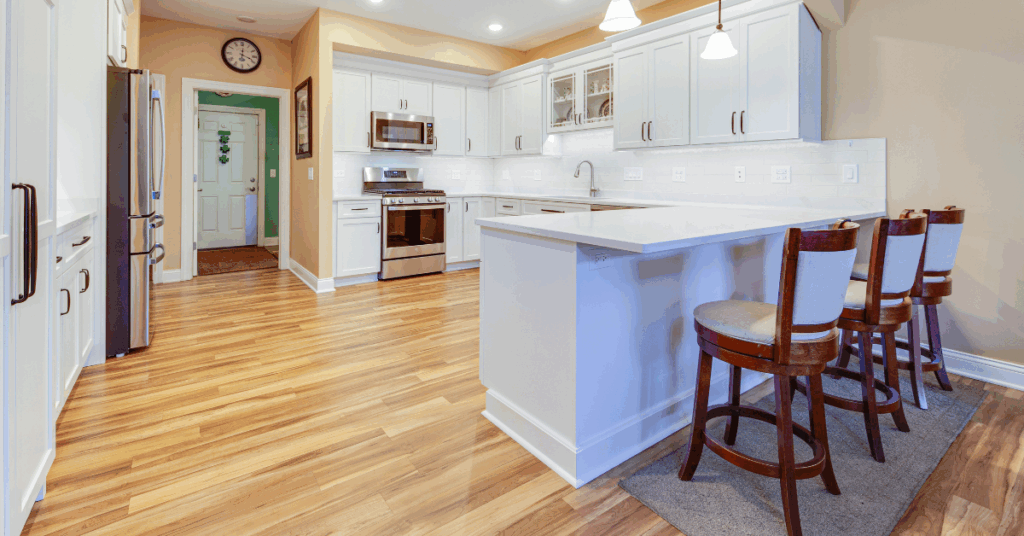How to Pair Countertops with Kitchen and Bathroom Designs: A Comprehensive Guide

Designing a cohesive and beautiful space starts with understanding how each element in your kitchen or bathroom interacts—especially your countertops. Your countertops are one of the most visually dominant surfaces in the kitchen and bathroom, and the right choice can elevate the entire look and feel of the space.
In this guide, we’ll walk you through how to successfully pair countertops with cabinet colors, flooring, backsplash, lighting, and overall design style—whether you’re working with a designer, an architect, or managing a renovation yourself. We’ll also explore the difference between prefabricated and custom countertops and why custom solutions are often the best fit for high-end homes.

Choosing Countertops for Your Kitchen
Your kitchen countertop does more than just provide a work surface—it sets the tone for the entire space. The right material can enhance both the beauty and functionality of one of the most-used areas in your home.
Consider Function First
Start by evaluating your cooking habits. If you cook often, quartz is an excellent low-maintenance choice that resists stains and scratches. For more heat resistance and a natural look, granite or quartzite may be a better fit.
Think About Style
- Your countertops should complement the overall style of your kitchen:
- Modern kitchens benefit from clean, solid tones in quartz or dramatic veining in quartzite.
- Farmhouse or rustic kitchens pair beautifully with leathered granite or natural stone.
- Traditional kitchens look stunning with marble-inspired quartz and rounded edge profiles.
Plan for Workflow
Consider how your kitchen is used daily. An island with a waterfall edge can double as a prep area and seating space. Peninsulas and L-shaped counters benefit from a rounded edge to soften the look and improve safety.
Popular Choices for Kitchens:
- Quartz for its easy maintenance and style variety.
- Granite for durability and a natural stone feel.
- Quartzite for homeowners who want a luxurious, heat-resistant surface.
- Porcelain for those seeking ultra-modern, thin-profile aesthetics.

Choosing Countertops for Your Bathroom
Bathroom countertops may be smaller in size than kitchen surfaces, but they play a major role in both the function and aesthetics of the space. When selecting the best countertop material for your bathroom, there are a few unique considerations that can make all the difference in both everyday use and long-term satisfaction.
- Moisture resistance is key in bathroom environments. Materials like quartz are ideal because they are non-porous, meaning they won’t absorb water or allow bacteria and mold to grow—a common concern in damp spaces. This makes quartz a top choice for both main bathrooms and guest baths.
- Light-colored countertops—such as white, beige, or soft gray quartz—can help make small bathrooms feel more open and airy. These shades reflect more light and can enhance the sense of space, especially when paired with mirrored vanities or light cabinetry.
- Easy maintenance is another essential factor. Polished stone surfaces like granite and quartz are naturally smooth and help prevent moisture from collecting in crevices. This reduces the chance of mildew buildup, making them easier to clean and more hygienic.
- For a high-end, spa-inspired look, marble and quartzite are excellent choices. While they require a bit more maintenance, their luxurious veining and organic elegance can dramatically elevate a master bathroom or powder room, especially when paired with custom cabinetry and upscale fixtures.
- Consider how the countertop pairs with your sink style as well—vessel sinks, undermount basins, or integrated sinks may all influence which materials or edge profiles work best.
Matching Countertops with Cabinets: Color Harmony and Contrast
The relationship between your cabinets and countertops sets the tone for your kitchen or bathroom. Here’s how to achieve a cohesive look:
1. Go for Contrast or Continuity
Contrast: Dark cabinets pair well with light countertops (e.g., navy with white quartz), creating a bold, modern look.
Continuity: Pair similar tones for a soft, seamless aesthetic, like warm beige cabinetry with ivory granite or light wood with soft gray quartz.
2. Complement Undertones
Look beyond the primary color and match or complement the undertones of your cabinets and countertop materials. Warm undertones (gold, red, yellow) pair well together; the same goes for cool undertones (blue, green, gray).
3. Use a Neutral Base
A neutral countertop like white quartz or Luna Pearl granite can anchor the space and let bolder cabinet colors shine.
Coordinating Countertops with Flooring and Backsplash
Cohesion Is Key
Choose materials that complement each other in texture, color, and finish. For instance, if you have patterned flooring, opt for simpler countertops to avoid overwhelming the eye.
Common Mistakes to Avoid
- Matching everything exactly—this can make the space feel flat.
- Choosing too many competing patterns.
- Ignoring undertones in your backsplash grout or cabinet hardware.
Picking the Perfect Countertop Color and Finish for Your Space
Color and finish aren’t just decorative—they affect the feel, function, and maintenance of your surfaces.
Popular Color Trends:
- White & Off-white: Brightens and opens the space; works with nearly every style.
- Gray: A neutral favorite that adds sophistication and hides mess well.
- Black: Sleek and dramatic; ideal for ultra-modern or industrial kitchens.
- Beige/Taupe: Earthy, natural, and inviting—perfect for transitional designs.
Finish Options:
- Polished: Glossy and reflective; great for modern kitchens.
- Honed: Matte finish; ideal for rustic or farmhouse kitchens.
- Leathered: Textured, low-sheen; provides a tactile feel and hides fingerprints.
Lighting and Countertop Pairing
- Low-Light Rooms: Go with light countertops to reflect natural light and open the space.
- Bright Spaces: Bold or darker countertops will look less harsh under strong lighting.
Undercabinet lighting can highlight veining and texture in granite or quartzite beautifully.

How to Pair Countertops with Wall Paint Colors
The pairing of your countertop and wall paint can set the tone for the entire room. Here’s how to make sure your choices work together harmoniously.
Complement or Contrast?
When coordinating countertops with wall colors, you have two main options:
- Complementary pairing: Choose colors that are within the same tone family for a cohesive, calm aesthetic. For example, a warm-toned quartz countertop pairs beautifully with creamy beige or taupe walls. This approach works well in spaces where you want a soft, inviting feel.
- Contrasting pairing: Use bold countertop colors to stand out against neutral or light walls. A deep black granite countertop against crisp white walls creates striking visual contrast and drama, ideal for contemporary or high-end designs.
Understanding Undertones
Undertones are the hidden hues that influence how colors interact with each other—and they’re often the reason two elements that should match end up clashing.
- Warm undertones (think gold, yellow, or red) work best with other warm tones. If you have walls in a soft sand or cream color, consider countertops with warm flecks like Calacatta Gold quartz or Sunset Canyon granite.
- Cool undertones (like blue, green, or gray) pair well with countertops in the gray, white, or black families—such as Carrara Mist quartz or Silver Cloud granite.
- Neutral undertones are versatile and can lean either warm or cool depending on what they’re next to. If your wall color is neutral, you have more flexibility when selecting countertops—but still keep undertones in mind to avoid subtle mismatches.
Popular Paint & Countertop Combinations
- White walls → Pair with nearly any countertop, from warm-toned quartz to dramatic black granite or bold veined marble.
- Gray walls → Work well with white quartz, polished granite, or cool-toned marble like Fantasy Brown.
- Beige or taupe walls → Complement warm granite like New Venetian Gold granite or neutral quartz with tan and cream veining.
- Dark navy or charcoal walls → Add contrast with white or light-toned countertops like White Valley granite or Everest quartz for a clean, modern look.
Before finalizing your paint color, bring home a small sample of your countertop or use color visualization tools to test pairings. Lighting can also influence how both the stone and paint appear in your space, so observe them in different light conditions before making a final decision.
Tip: You can pick up samples of your selected countertop material at our showroom, so you can bring them home and compare finishes in your own lighting and space.
Design Tips for Open Concept Spaces
In open floor plans, countertops are often visible from dining or living areas. Choose materials and colors that complement adjacent finishes like flooring, wall colors, and furniture.
Consider:
- Waterfall edges for continuity.
- Multi-functional surfaces (e.g., island with seating).
- Integrated power outlets for added functionality.
Material Suggestions by Design Style
- Modern: Sleek quartz with sharp edges and polished finish.
- Traditional: Warm granite or marble with ogee or bullnose edge.
- Scandinavian: Soft white or gray quartz with minimal veining.
- Rustic/Farmhouse: Leathered granite or butcher block mixed with stone.
- Transitional: Neutral tones with a mix of modern and classic elements.
Mixing Materials: A Designer’s Secret Weapon
Mixing materials—like wood and stone—adds dimension and visual interest. A wood-topped island surrounded by quartz countertops offers a balanced contrast that works well in eclectic or transitional kitchens.
Prefabricated vs. Custom Countertops: What’s the Difference?
Prefabricated:
- Pros: Lower cost, faster turnaround.
- Cons: Limited sizes, edge profiles, and color choices.
Custom:
- Pros: Tailored dimensions, unlimited design options, premium finishes.
- Cons: Longer lead time, slightly higher cost.
For high-end or uniquely designed homes, custom countertops offer a superior finish, better integration with existing elements, and a personalized design experience.
The Advantages of Custom Countertops for Your Home
- Vein Matching: Create seamless patterns across multiple slabs.
- Unique Edges: Choose intricate or bold edge profiles to enhance the design.
- Precision Fit: Digital laser measurements ensure perfect cuts around sinks, cooktops, or unusual layouts.
- Higher ROI: Custom surfaces often add more value to a home, especially in competitive real estate markets.
Countertop Trends for 2025
- Colors: Warm whites, soft taupes, and dramatic black quartz.
- Materials: Quartz still leads, followed by quartzite and porcelain.
- Edges: Eased and mitered waterfall edges are on the rise.
- Texture: Honed and leathered finishes gaining popularity.
If resale is a factor, choose classic neutral colors and avoid highly personalized choices for large surfaces.
Tips for Resale Value Through Strategic Pairing
If you’re planning to sell in the near future, opt for countertop and cabinet pairings that appeal to a broad audience. Neutral quartz with white or gray cabinetry is always a safe, stylish choice.
Real-Life Pairings That Work
- Modern Farmhouse: White shaker cabinets with honed granite countertops and matte black fixtures.
- Transitional Style: Warm gray cabinetry with polished quartz and brushed nickel hardware.
- Bold & Contemporary: High-gloss navy cabinets with white Calacatta quartz and waterfall edge.
- Spa-Like Bathrooms: Light oak vanities with beige quartz and vessel sinks.
Final Thoughts
Pairing the right countertops with your kitchen or bathroom design is about more than color—it’s about creating a space that feels cohesive, functional, and tailored to your lifestyle. Whether you’re a homeowner, designer, or architect, working with a trusted countertop company like Masters Countertops ensures a smoother process and exceptional results.
Explore our showroom in Wheeling, IL or browse our materials online. Let’s create something beautiful together.
Like what you see? Follow us for more design inspiration, expert tips, and the latest trends in natural stone and quartz countertops. Don’t forget to share!
